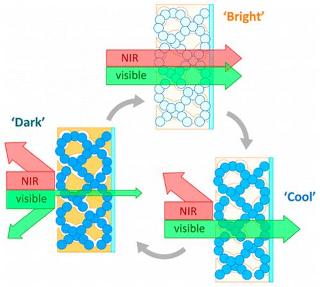A team of researchers in the Cockrell School of Engineering at The University of Texas at Austin are one step closer to delivering smart windows with advanced energy efficient, engineering materials capable of allowing windows to reveal light without transferring heat-transfer and, conversely, capable of restricting light while allowing heat to pass through.
 The illustration demonstrates the dark, bright and cool mode made possible by the researchers' new architected nanocomposite. The team organized the two components of the composite material to create a porous interpenetrating network. This organization enables substantially faster switching between modes. (CREDIT - Cockrell School of Engineering)
The illustration demonstrates the dark, bright and cool mode made possible by the researchers' new architected nanocomposite. The team organized the two components of the composite material to create a porous interpenetrating network. This organization enables substantially faster switching between modes. (CREDIT - Cockrell School of Engineering)
The novel materials could greatly minimize costs for heating and cooling buildings by allowing the occupants of the buildings to very accurately control the energy and sunlight passing via a window.
The first dual-band electrochromic materials were developed by chemical engineering professor Delia Milliron and her team in 2013. These materials were a blend of two materials possessing distinctive optical properties for selectively monitoring heat-producing near-infrared (NIR) and visible light.
Milliron's research team illustrated the ways a small jolt of electricity can be used to cause a nanocrystal material to switch back and forth, thereby enabling autonomous control of light and energy. This research was published in the 2013 issue of Nature.
Recently, Milliron's team has developed two novel advancements in electrochromic materials, which are a highly selective cool mode and a warm mode. These features were believed to be impossible in the past.
Specifically, the cool mode material is a breakthrough step toward a commercialized product. The reason is that it enables control of 90% of NIR and 80% of the visible light from the sun, and requires just a few minutes to switch between modes. Similar type of materials created before this one required hours for switching between modes.
To achieve this feat, Milliron’s team along with Cockrell School postdoctoral researcher Jongwook Kim and collaborator Brett Helms of the Lawrence Berkeley National Lab constructed a novel nanostructured architecture for electrochromic materials which allows a cool mode to restrict near-infrared light and at the same time allows visible light to pass through. The nanostructured architecture could facilitate decrease of energy costs by cooling homes and buildings during the summer. The novel architecture was illustrated in Nano Letters on July 20.
We believe our new architected nanocomposite could be seen as a model material, establishing the ideal design for a dual-band electrochromic material. This material could be ideal for application as a smart electrochromic window for buildings.
Milliron
In the research paper, the team explains the process involved in using the novel material to strongly and selectively adjust visible light and NIR by passing a small voltage.
The researchers arranged the two components of the composite material to develop a porous interpenetrating system to improve the performance of electrochromics for commercial use. The framework architecture acts as a channel for transporting electronic and ionic change. It also enables considerably quicker switching between modes.
Currently, Milliron's team is working to manufacture a similarly structured nanocomposite material using simple techniques that will help reduce manufacturing cost.
In a second research paper, Milliron and her team, along with Cockrell School graduate student Clayton Dahlman, have illustrated using a proof-of-concept demonstration on the methods used by them to realize optical control properties in windows from a highly well-designed single-component film.
The concept entails a simple coating which develops a new warm mode, in which visible light can be restricted, while simultaneously allowing near-infrared light to pass. This advancement would be ideal for a sunny winter day when the occupants in a building would require infrared radiation to pass into a building for warmth, and at the same time would require the glare of the sunlight to be minimized.
Milliron demonstrated that a coating comprising a single component such as doped titania nanocrystals, could provide superior control over the flow of solar radiation. This material can selectively restrict visible or infrared radiation due to the presence of two diverse charging mechanisms found at contrating applied voltages.
This research finding was published in the Journal of the American Chemical Society.
These two advancements show that sophisticated dynamic control of sunlight is possible. We believe our deliberately crafted nanocrystal-based materials could meet the performance and cost targets needed to progress toward commercialization of smart windows.
Milliron
References